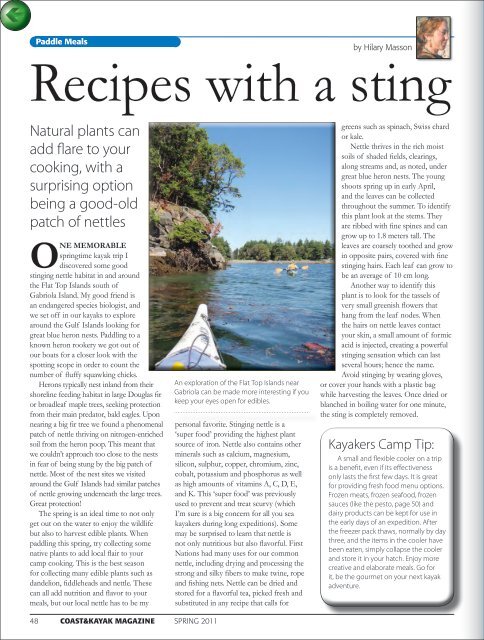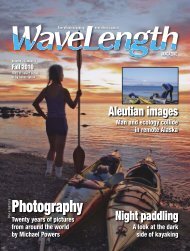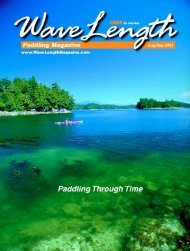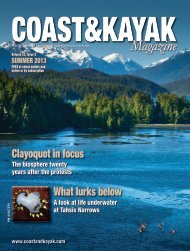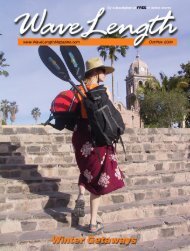a kayak - Wavelength Paddling Magazine
a kayak - Wavelength Paddling Magazine
a kayak - Wavelength Paddling Magazine
You also want an ePaper? Increase the reach of your titles
YUMPU automatically turns print PDFs into web optimized ePapers that Google loves.
Paddle Meals<br />
by Hilary Masson<br />
Recipes with a sting<br />
Natural plants can<br />
add flare to your<br />
cooking, with a<br />
surprising option<br />
being a good-old<br />
patch of nettles<br />
ONE MEMORABLE<br />
springtime <strong>kayak</strong> trip I<br />
discovered some good<br />
stinging nettle habitat in and around<br />
the Flat Top Islands south of<br />
Gabriola Island. My good friend is<br />
an endangered species biologist, and<br />
we set off in our <strong>kayak</strong>s to explore<br />
around the Gulf Islands looking for<br />
great blue heron nests. <strong>Paddling</strong> to a<br />
known heron rookery we got out of<br />
our boats for a closer look with the<br />
spotting scope in order to count the<br />
number of fluffy squawking chicks.<br />
Herons typically nest inland from their<br />
shoreline feeding habitat in large Douglas fir<br />
or broadleaf maple trees, seeking protection<br />
from their main predator, bald eagles. Upon<br />
nearing a big fir tree we found a phenomenal<br />
patch of nettle thriving on nitrogen-enriched<br />
soil from the heron poop. This meant that<br />
we couldn’t approach too close to the nests<br />
in fear of being stung by the big patch of<br />
nettle. Most of the nest sites we visited<br />
around the Gulf Islands had similar patches<br />
of nettle growing underneath the large trees.<br />
Great protection!<br />
The spring is an ideal time to not only<br />
get out on the water to enjoy the wildlife<br />
but also to harvest edible plants. When<br />
paddling this spring, try collecting some<br />
native plants to add local flair to your<br />
camp cooking. This is the best season<br />
for collecting many edible plants such as<br />
dandelion, fiddleheads and nettle. These<br />
can all add nutrition and flavor to your<br />
meals, but our local nettle has to be my<br />
An exploration of the Flat Top Islands near<br />
Gabriola can be made more interesting if you<br />
keep your eyes open for edibles.<br />
personal favorite. Stinging nettle is a<br />
‘super food’ providing the highest plant<br />
source of iron. Nettle also contains other<br />
minerals such as calcium, magnesium,<br />
silicon, sulphur, copper, chromium, zinc,<br />
cobalt, potassium and phosphorus as well<br />
as high amounts of vitamins A, C, D, E,<br />
and K. This ‘super food’ was previously<br />
used to prevent and treat scurvy (which<br />
I’m sure is a big concern for all you sea<br />
<strong>kayak</strong>ers during long expeditions). Some<br />
may be surprised to learn that nettle is<br />
not only nutritious but also flavorful. First<br />
Nations had many uses for our common<br />
nettle, including drying and processing the<br />
strong and silky fibers to make twine, rope<br />
and fishing nets. Nettle can be dried and<br />
stored for a flavorful tea, picked fresh and<br />
substituted in any recipe that calls for<br />
greens such as spinach, Swiss chard<br />
or kale.<br />
Nettle thrives in the rich moist<br />
soils of shaded fields, clearings,<br />
along streams and, as noted, under<br />
great blue heron nests. The young<br />
shoots spring up in early April,<br />
and the leaves can be collected<br />
throughout the summer. To identify<br />
this plant look at the stems. They<br />
are ribbed with fine spines and can<br />
grow up to 1.8 meters tall. The<br />
leaves are coarsely toothed and grow<br />
in opposite pairs, covered with fine<br />
stinging hairs. Each leaf can grow to<br />
be an average of 10 cm long.<br />
Another way to identify this<br />
plant is to look for the tassels of<br />
very small greenish flowers that<br />
hang from the leaf nodes. When<br />
the hairs on nettle leaves contact<br />
your skin, a small amount of formic<br />
acid is injected, creating a powerful<br />
stinging sensation which can last<br />
several hours; hence the name.<br />
Avoid stinging by wearing gloves,<br />
or cover your hands with a plastic bag<br />
while harvesting the leaves. Once dried or<br />
blanched in boiling water for one minute,<br />
the sting is completely removed.<br />
Kayakers Camp Tip:<br />
A small and flexible cooler on a trip<br />
is a benefit, even if its effectiveness<br />
only lasts the first few days. It is great<br />
for providing fresh food menu options.<br />
Frozen meats, frozen seafood, frozen<br />
sauces (like the pesto, page 50) and<br />
dairy products can be kept for use in<br />
the early days of an expedition. After<br />
the freezer pack thaws, normally by day<br />
three, and the items in the cooler have<br />
been eaten, simply collapse the cooler<br />
and store it in your hatch. Enjoy more<br />
creative and elaborate meals. Go for<br />
it, be the gourmet on your next <strong>kayak</strong><br />
adventure.<br />
48 COAST&KAYAK MAGAZINE SPRING 2011


